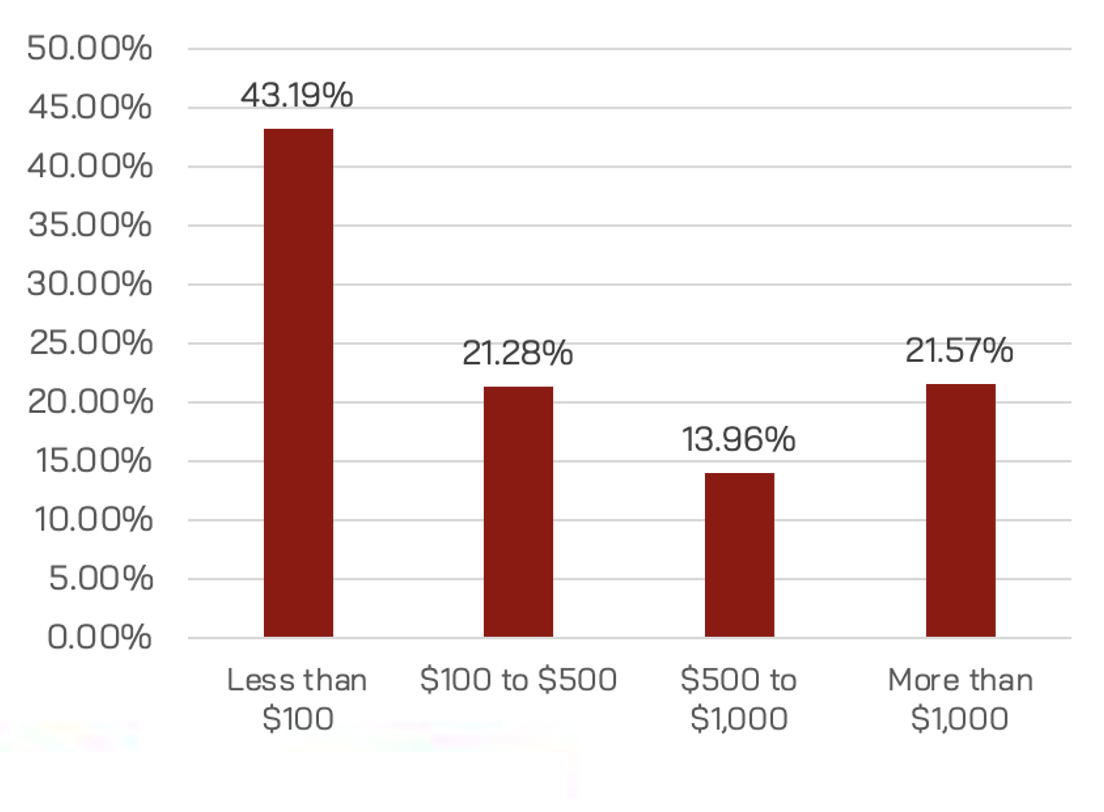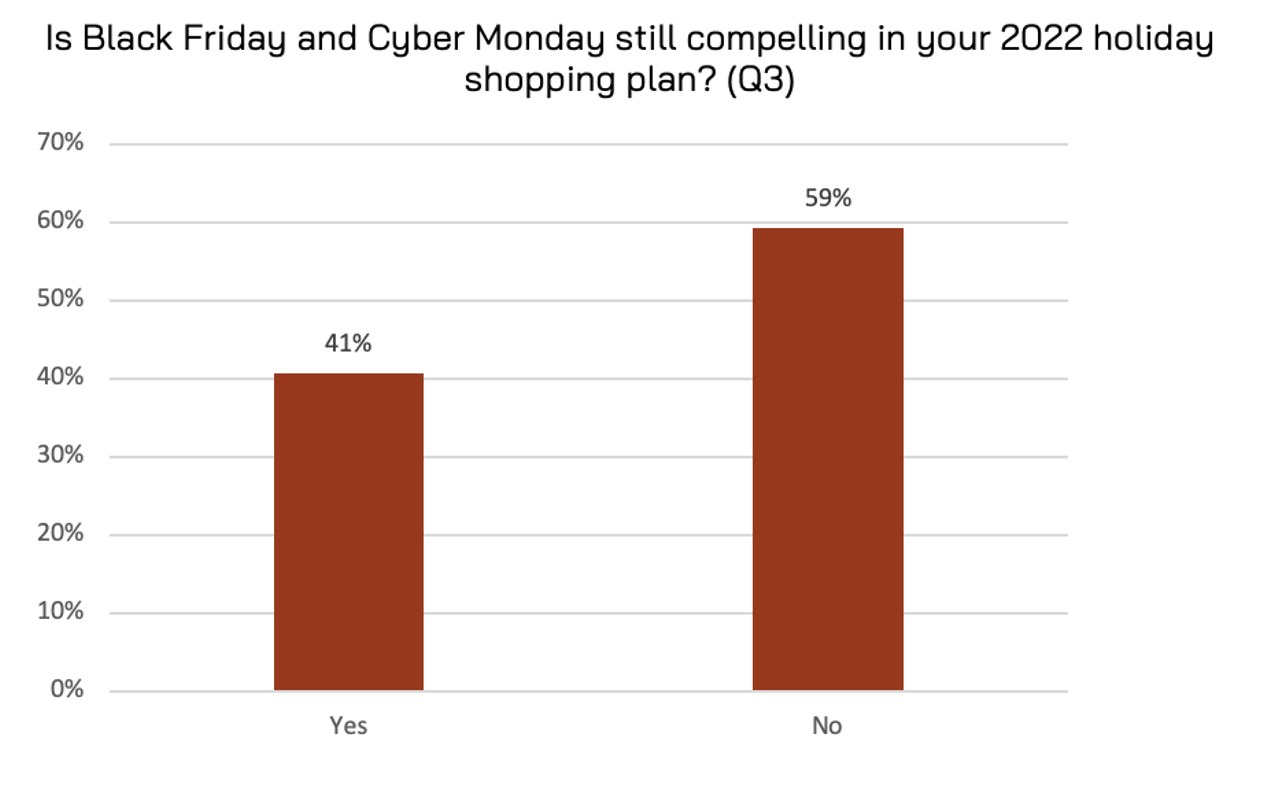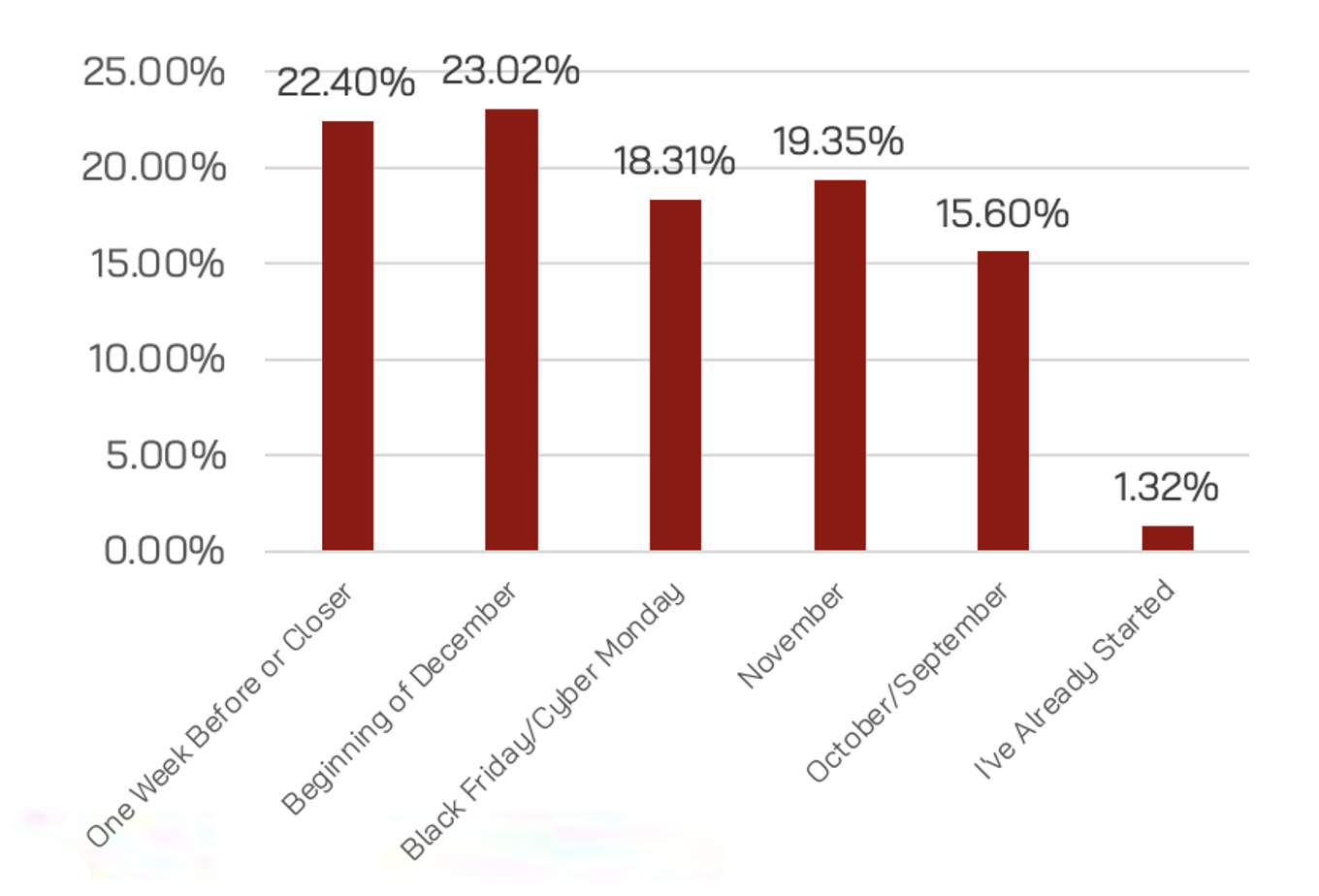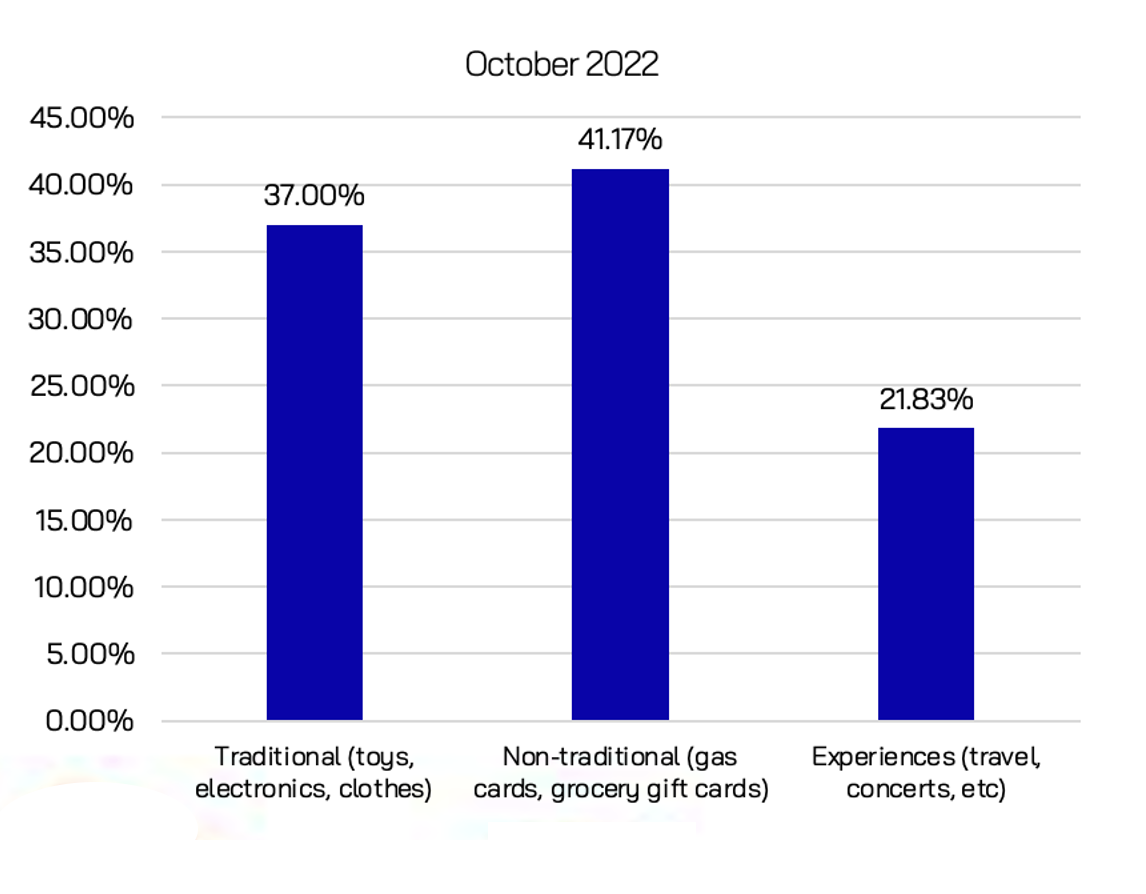
Zeta’s 2022 Holiday Marketing & Retail Trends Report
UPDATE FOR BLACK FRIDAY & CYBER MONDAY THROUGH DECEMBER 2022: Here at Zeta, we ran a survey in June and July to thousands of customers across North America with the goal of understanding how they plan to alter their 2022 holiday shopping habits compared to previous years. We’ve kept all the results below but the trends all pointed to one major concern weighing over how consumers planned to shop this holiday season: inflation. In fact, nearly a third of respondents said that they can no longer spend their money on purchases outside of necessities like food and gas. Similarly, nearly 45% of all consumers said that their main focus when it comes to shopping this year has to do with the price of products or whether or not companies are offering discounts or coupons for their products. Now that we’re closer to Black Friday & Cyber Monday, we wanted to understand if these consumer sentiments have changed or if shoppers are staying steadfast in their beliefs. So, we interviewed over 3,000 more consumers throughout October and came back with the following results. Take a look below.
Holiday Spending Will Continue to Be Thrifty

When we first interviewed respondents in July, the number of people who felt that they’d need to reign in their spending this holiday season was only around 25% and the total amount who felt they can’t purchase anything but necessities this year was around 34%. While not a massive increase for each of those audience segments, there are more people who currently feel they need to make changes to their spending habits than there have been in previous years. Simultaneously, as you can see below, there is a bifurcation that’s begun to emerge when it comes to how users plan to spend their money with the majority of respondents either planning to spend over $1,000 this year or under $100. This trend of consumers being polarized towards each end of the purchasing spectrum has actually evened out a bit since we last spoke with consumers, as more people began to shift their spending expectations downward as we hit October.  So what does this all mean for marketers? That it’s not as doom and gloom as you might expect. While consumers on average plan to spend less this year, over one-fifth of respondents still plan to spend at least four figures. What these recent trends emphasize is the need for marketers to employ incredibly powerful personalization capabilities this year more than any other. Why? Because there will be fewer consumer dollars to compete for meaning someone who made have made 2 or 3 purchases in the past is now only making one or two. Every marketing touch that you have with consumers therefore becomes critically important. Ensure that you’re working with a vendor who can help you hyper personalize your messaging to the specific online behaviors and shopping interests of each of your target customers so that you don’t push them off of your brand with inconsistent or irrelevant messaging.
So what does this all mean for marketers? That it’s not as doom and gloom as you might expect. While consumers on average plan to spend less this year, over one-fifth of respondents still plan to spend at least four figures. What these recent trends emphasize is the need for marketers to employ incredibly powerful personalization capabilities this year more than any other. Why? Because there will be fewer consumer dollars to compete for meaning someone who made have made 2 or 3 purchases in the past is now only making one or two. Every marketing touch that you have with consumers therefore becomes critically important. Ensure that you’re working with a vendor who can help you hyper personalize your messaging to the specific online behaviors and shopping interests of each of your target customers so that you don’t push them off of your brand with inconsistent or irrelevant messaging.
Be Careful When Assessing This Year’s Shopping Stats
A lot of data can be tricky to understand when it comes to how we interpret it and deduce findings about shopping behaviors. For example, we noticed that when asking where consumers plan to shop this holiday season, even more stated that they plan to shop online when we surveyed them earlier this Fall than they did when we asked this question back at the beginning of the summer. However, it has still been shown that in-store and brick-and-mortar shopping numbers beat digital shopping numbers when it comes to total sales driven. This is likely to remain the same this year as many people get back to their pre-pandemic shopping habits. What the graph below best illustrates in the need for marketers to ensure they’re employing an omnichannel approach to targeting and converting their consumers. Work with a brand that can help you identify consumers both in-store and online, and then target them across both high-converting and platform-agnostic channels like email, SMS, programmatic, social, and more.  In keeping with the trend of potentially misinterpreting data, there has been a large focus on the “Death of Black Friday & Cyber Monday.” In fact, we found below that nearly 60% of respondents don’t feel either of those holidays are compelling for them when it comes to their holiday shopping. This data shouldn’t be taken at face value as many companies still see their largest shopping days of the year coming from the five days from Thanksgiving through to Cyber Monday. What the graph below is emphasizing is that more and more consumers are spreading out their shopping from November through December, and sometimes even earlier than that.
In keeping with the trend of potentially misinterpreting data, there has been a large focus on the “Death of Black Friday & Cyber Monday.” In fact, we found below that nearly 60% of respondents don’t feel either of those holidays are compelling for them when it comes to their holiday shopping. This data shouldn’t be taken at face value as many companies still see their largest shopping days of the year coming from the five days from Thanksgiving through to Cyber Monday. What the graph below is emphasizing is that more and more consumers are spreading out their shopping from November through December, and sometimes even earlier than that.  This is showcased by looking at the chart below. In fact, contrary to popular belief, you have not missed out on all of your sales if you begin to target your consumers right now. December is the largest shopping month in terms of total responses given, with nearly a quarter of people planning to wait until the week leading up to Christmas. This chart is from our Autumn respondents, but is nearly identical to the responses that were given at the beginning of the summer showcasing that consumer’s attitudes around when they’re going to shop are not shifting over time. Make sure you aren’t blowing too much of your marketing budget before Black Friday & Cyber Monday or you’ll likely miss out on a significant portion of consumers who may have purchased with your brand but were waiting until the last minute to do so.
This is showcased by looking at the chart below. In fact, contrary to popular belief, you have not missed out on all of your sales if you begin to target your consumers right now. December is the largest shopping month in terms of total responses given, with nearly a quarter of people planning to wait until the week leading up to Christmas. This chart is from our Autumn respondents, but is nearly identical to the responses that were given at the beginning of the summer showcasing that consumer’s attitudes around when they’re going to shop are not shifting over time. Make sure you aren’t blowing too much of your marketing budget before Black Friday & Cyber Monday or you’ll likely miss out on a significant portion of consumers who may have purchased with your brand but were waiting until the last minute to do so. 
Consumers Stray From Traditional & Expensive Gifts
Traditional gifts still see a significant amount of interest in terms of the total number of purchases people plan to make when looking at each of the different gifting categories below — largely led by older generations likely buying them for grandkids. However, the total amount of respondents who say that they plan on non-traditional gifts (such as a gift card to help with a grocery trip) and experiential gifts (like trips and band concerts) are both seeing a rise in responses. Much of these changes are led by younger generations who likely value a music festival more than older generations would. They’re also likely influenced by inflation and people having tighter wallets than in years past. So expect, to see these trends continue to stay the same through the end of the year as more and more people finalize their holiday shopping plans.  These trends play into our final graph, by showcasing just how much people care about pricing this holiday season. Compared with this summer, more respondents listed pricing as important to how they plan to make a purchase this year and a near equal amount listed coupons and discounts as something that will be driving what they choose to buy this year. If you have prices that beat out competitors, are offering a sale, or can showcase the long-term value of making a purchase with your brand then you need to be highlighting that in your marketing materials this holiday season. You will point blank be loosing sales if you are not doing this. Finally, don’t be scared to highlight the uniqueness or positive reviews that your products are seeing. When not talking about pricing, most shoppers usually want to see that other people have bought your products and love them or that they’ll be the only one they know with your unique product and can show it off to family and friends.
These trends play into our final graph, by showcasing just how much people care about pricing this holiday season. Compared with this summer, more respondents listed pricing as important to how they plan to make a purchase this year and a near equal amount listed coupons and discounts as something that will be driving what they choose to buy this year. If you have prices that beat out competitors, are offering a sale, or can showcase the long-term value of making a purchase with your brand then you need to be highlighting that in your marketing materials this holiday season. You will point blank be loosing sales if you are not doing this. Finally, don’t be scared to highlight the uniqueness or positive reviews that your products are seeing. When not talking about pricing, most shoppers usually want to see that other people have bought your products and love them or that they’ll be the only one they know with your unique product and can show it off to family and friends.  Lastly, if you want a more in-depth analysis of everything holiday marketing related then please feel free to take a look at our Holiday Marketing Trends Report where you can find even more fun graphs and deep dive analyses on how consumers plan to shop this Holiday season.
Lastly, if you want a more in-depth analysis of everything holiday marketing related then please feel free to take a look at our Holiday Marketing Trends Report where you can find even more fun graphs and deep dive analyses on how consumers plan to shop this Holiday season.
DATA BELOW THIS FROM SUMMER 2022
COVID had a good run, but this year, there’s a new sheriff in town throwing a wrench in holiday shopping. Welcome to the stage: inflation. Shoppers are tightening their budgets to weather the storm of economic change, but that doesn’t mean that brands can’t still create holiday marketing campaigns that reach their target consumers and convert them into paying customers. In fact, this year more than ever is an opportunity to edge out the competition with highly relevant and personalized marketing messaging that shows your audience you truly care about their shopping behaviors. To help you out this year, we ran a survey to thousands of consumers across the United States to discover how they plan to approach everything from their budget, to their spending, and even their shopping habits this upcoming holiday season. We then used that data and sat down with our own internal retail industry experts to reveal the strategies you should follow to drive the most success this holiday season. We wrapped this all up into a brand new guide that reveals how consumers plan to shop this holiday season, where they plan to make their purchases, and how much they plan to spend from now until the end of the year. Here’s a sneak peak around what we learned.
Holiday Spending will be Thrifty
 File under polarizing finds, most consumers plan to have either a very tight budget or spend more than they did last year. We’ve found there really is no in between. 42% of consumers plan to spend under $100 for their entire shopping budget, a seemingly scant amount to cover friends and family members. Additionally, nearly 60% of all respondents said that they have to rein in their spending, or are only devoting resources to necessities like food or gas. It’s not all coal in the stockings though! Over 26% of consumers plan to spend more than $1,000 this year and do not seem fazed by the inflationary economy. In order to reach the high-spender bracket, make sure that you’re employing a healthy digital marketing strategy. Our survey revealed that those who do plan to spend more this holiday season plan to do most of their shopping online vs. directly in-store.
File under polarizing finds, most consumers plan to have either a very tight budget or spend more than they did last year. We’ve found there really is no in between. 42% of consumers plan to spend under $100 for their entire shopping budget, a seemingly scant amount to cover friends and family members. Additionally, nearly 60% of all respondents said that they have to rein in their spending, or are only devoting resources to necessities like food or gas. It’s not all coal in the stockings though! Over 26% of consumers plan to spend more than $1,000 this year and do not seem fazed by the inflationary economy. In order to reach the high-spender bracket, make sure that you’re employing a healthy digital marketing strategy. Our survey revealed that those who do plan to spend more this holiday season plan to do most of their shopping online vs. directly in-store.
Consumers will use Multiple Channels to Shop
 Shoppers will learn about your products and interact with your brand in the way that makes them feel most comfortable. This means that your holiday marketing campaigns can’t just run across one or two channels. Start by mapping all of your customer journeys and understanding all of the touch points that lead to the sale. This will help you understand the channels that educate your customers about your products, as well as the ones that most often drive users back to your site. Ensure that you’re working with a marketing vendor who can give you insight into all of these different touchpoints but don’t pour all of your budget into one specific channel. As you can see in the graph, users want to use multiple different platforms when it comes to their holiday shopping. In order to reach these consumers no matter where they are you’ll need to break out of the walled gardens that come from marketing directly with one platform vs. another. Instead, employ a marketing vendor that can extend your reach across all channels online and in-store.
Shoppers will learn about your products and interact with your brand in the way that makes them feel most comfortable. This means that your holiday marketing campaigns can’t just run across one or two channels. Start by mapping all of your customer journeys and understanding all of the touch points that lead to the sale. This will help you understand the channels that educate your customers about your products, as well as the ones that most often drive users back to your site. Ensure that you’re working with a marketing vendor who can give you insight into all of these different touchpoints but don’t pour all of your budget into one specific channel. As you can see in the graph, users want to use multiple different platforms when it comes to their holiday shopping. In order to reach these consumers no matter where they are you’ll need to break out of the walled gardens that come from marketing directly with one platform vs. another. Instead, employ a marketing vendor that can extend your reach across all channels online and in-store.
Pricing and Variability are Top-of-Mind
Discounts, discounts, discounts. In short, if you can offer them, then you should. When probed, nearly 30% of respondents said that better pricing led them to choosing one vendor over another. Because of the volatility in the market earlier in the summer and the fear of an upcoming recession, discounts are taking precedence over things like the cache a brand might have for consumers this year. Use language that highlights any discounts, sales, or price reductions that you’re offering to stand out from the crowd.  We’re also aware that not every brand can offer discounts. Sometimes it’s because they aren’t financially viable or they would hurt your overall brand perception. We get it and there are workarounds. In that same survey, a combined 26% of all people mentioned that uniqueness and greater selection were two swaying factors in selecting a vendor. If discounts aren’t your thing, showcase the variability in your product offering to reel in new consumers. You can also highlight the uniqueness of your brand when marketing to consumers. Use your campaigns to showcase the fact that shoppers can only buy your one-of-a-kind product in your stores to create the drive to buy.
We’re also aware that not every brand can offer discounts. Sometimes it’s because they aren’t financially viable or they would hurt your overall brand perception. We get it and there are workarounds. In that same survey, a combined 26% of all people mentioned that uniqueness and greater selection were two swaying factors in selecting a vendor. If discounts aren’t your thing, showcase the variability in your product offering to reel in new consumers. You can also highlight the uniqueness of your brand when marketing to consumers. Use your campaigns to showcase the fact that shoppers can only buy your one-of-a-kind product in your stores to create the drive to buy.
Want to discover more?
Check out our newest publication, The 2022 Holiday Retail Marketing Guide, to see how over 3000 consumers across North America plan to shop this upcoming holiday season. In the guide you’ll find tips, tricks, and strategies for more easily reaching and converting these consumers during a season where many shoppers are tightening their belts. You can also reach out directly to one of our holiday marketing experts today who can help create a custom-made marketing plan that’s tailor made to meet your businesses unique goals.


